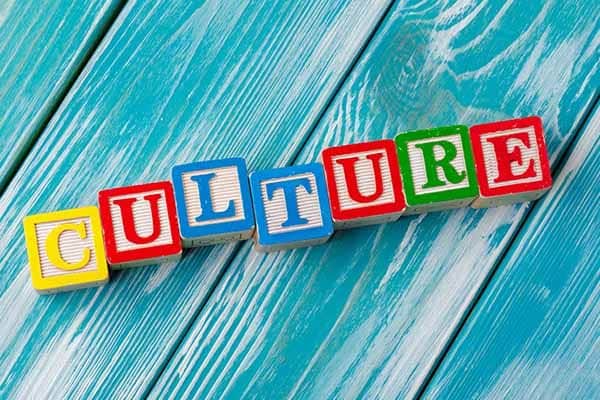The Role Of Culture And Leadership

About The Brand Enabled Podcast & all episodes
I’m here with Rachel Cross. Rachel, say hello to the gang.
Hi, everyone. Thanks, Greg, for having me.
Rachel, you and I have been talking, we both have an interest in culture and branding. Introduce yourself to people and talk a little bit about your perspective of what you’re doing as a leader now.
I love working with organizations and helping them align the areas of their brand. I’ll take a step back. There are many definitions of brand even among marketers today now. When I talk about brand, I’m talking about four specific areas. That’s culture, who they are, product, what they do. It could be product or service. Their experience, their customer journey, what do they feel like to their target audiences? Then finally the expression, which is what they sound like and what they look like. Most people think of brand as that last piece, like their logo and their website and their social media presence.
For me, it really starts with culture. It’s what I wanted to hammer in with you a little bit. We talk about digitally-enabled brands. What’s the digital challenge in this world? What’s the digital challenge with culture these days? Is this a different world every day? How do you see it?
We live in such a different world now. I’ve been working from home for eleven years when I first started my consulting business. I’ve been familiar with Zoom and all these tools forever, but in 2020, we saw this massive shift in how employees work and how companies allow employees to work and how they enable them to be productive. Right now, we’re seeing different companies do different things, and welcoming remote workers back to the office. Some of them mandating much to the chagrin of those employees. Then also companies that said, “We’re never going to go back to an office space.”
You cannot have an innovative culture if you don’t have trust and psychological safety.
Some companies are doing something in between saying, “It’s up to the manager or we’re going to allow a hybrid schedule and you can work from home sometimes and not others.” It’s interesting to talk about digitally enabling culture because as a piece of brand, I think it’s critical now in what’s happened in the world over the last few years because of the pandemic.
I have an organizational development background. I think if you can have satisfied employees, you’ll have satisfied customers. What have you been seeing in that digital world where we’re not in the hallways together, we don’t have lunch, we can’t reassure and get the social mores explained fast enough, and how to help people connecting satisfied employees to that virtual world so that they can be on brand? What’s happening there? Can you help our audience think about that?
The reality is every organization ideally will intentionally shape their culture. What was happening with many organizations is they were allowing the culture to organically grow, which is okay in some circumstances and the things that you’re talking about, the Water Cooler conversations and the lunches and the happy hours, those opportunities for people to get to know each other as humans, as people, as Joe who has a newborn baby and also a new puppy that they have to take care of, versus Joe, the sales analyst, for example. Those interactions now went away during the pandemic, and in some cases for good, and in some cases they’re coming back but very carefully.
Organizations now have to be hyper-focused on creating those personal interactions and making sure that people get to know each other, that teams understand who they’re working with when it comes to the people now that you’re just seeing on a Zoom screen. While I think the intentionality was always important, now you won’t survive without it, in my opinion.
It’s really hard because what are the unintended consequences for brands? It’s like, “I’m going to be intentional putting programs together,” and then I send out an email that’s a clunker. I think I said the right thing, but the wrong things happen. What are the guidelines that you’re seeing brands and brand managers talk about? How do they navigate? It’s so easy for the ambiguity of not seeing people’s body language and their head-nodding, to read all negativity into it. You’ve got all this ambiguity and you’d need to have all this more intentionality. None of us are really trained for it.

Digital Branding: Every organization ideally will intentionally shape its culture. But what was happening with many organizations is they were allowing the culture to grow organically.
That is true. You’re bringing up a point of in all of our lives, we don’t want to have any important emotionally-based conversations over text or email. I think the same is still true in business. To your point, you can’t read tone, intentions or motivations behind words on a screen. It’s a challenge that is falling for the most part to HR professionals.
What’s hard is that a lot of HR professionals are not experts in culture either because they’re experts in hiring and legalities, benefits, packages and those kinds of things. Now all of a sudden having to be an expert in organizational leadership, which you have a lot of experience in or psychology quite frankly, is a thing that we’re asking HR leaders to do that is or is not unfair, depending on who they are, and is or not unfair depending on executive sponsorship, which you and I were just talking about. Having a C-suite that cares about it and going to sponsor it and going to model it. That could be something like, “At our weekly Zoom meetings, we’re going to have our cameras on,” for example.
I’ve been in many meetings over the pandemic where I was the only one with my camera on, and these were client meetings. I thought, “I don’t know you. I want you to know me a little bit, so I would like you to see my face and my expressions to what you were alluding to before.” It’s an interesting time and challenge for a lot of people.
What I hear you saying is there’s a lot of nuance and very specific things that you have to think about in terms of setting the state. A Zoom call on an all-hands 1,500 person meeting is a modern day business opera orchestrated by someone who has to have on-brand psychology.
We’re asking a lot of people.
At its core, anything related to branding is telling a story.
You’ve got people with intentionality that are looking at culture. They’re trying to bring people together. There are hits and misses, there are ups and downs. How does this whole energy around bringing people and culture together, flow into the rest of the brand ideas that you manage or help people think through? Give us the connection between intentionality on culture, and then how do you extend it and build it for all the way down to brand expression?
I think of culture as being so critically foundational to all of those other pieces. Think about what we talked about. If you have employees who know each other personally, the reality is, and there are studies that show this, if you know who you’re working with, you’re more likely to like them. If you like who you’re working with, you’re more likely to collaborate. You’re more likely to take risks and be innovative, and you’re more likely to be productive with them, believe it or not. Now, you have a team that’s high-functioning when you have these people that have these connections. Hopefully, you also have some stated values of your organization and operating principles that give your team things to rally around in addition to the vision of whatever you’re trying to put out in the world.
Combine a lot of those things. What’s the impact you’re trying to make? What’s the difference you’re trying to make in the world? What are our values? Then we have these personal connections. When you have a high-functioning team, you’re going to put out hopefully a superior product or service, which is then going to delight your customer base. That can be from the experience of the actual product itself, but also customer service, all of those touch points that your customers have. Then we’re talking about the expression of it, maybe reflecting that customer experience. It’s testimonials or like, “Here’s the behind-the-scenes of what our employees and investors are doing.” There are many different implications for it.
Rachel, I’m watching you talk and I’m thinking, “Is she actually saying that we’re going to have to trust each other to be high-performers?” In this age, I see the trajectory of how it works well. Give us, “What do I do when it’s maybe not working so well?” and then I’ll give you your final question.
I’m glad you brought up trust. You cannot have an innovative culture if you don’t have trust and you don’t have psychological safety. I’ve seen this unfortunately in many different companies I’ve worked with where that does not exist. What you’re saying is it’s not working because it could be that there’s one toxic leader that creates this culture of if you speak up in a meeting with an idea that they don’t like, you’re going to get yelled at or ridiculed. Those are the kinds of environments where it doesn’t feel safe to actually take a risk and bring up something new or different, so innovation dies.

Digital Branding: If you know who you’re working with, you’re more likely to like them. If you like who you’re working with, you’re more likely to collaborate, take risks, be innovative, and be productive.
There has to be some executive sponsorship to want to take a look at that. The problem that they might see is we’re not being innovative, but really what happens after some of the work that people like I do is then we’re uncovering the real problem, which is maybe this toxic person. There are going to be some tough decisions to be made. It could be doing some leadership development training with them, understanding why are they the way they are going back to the psychology background. In some cases, it might be having to remove that person, and you are really reshaping a culture based on new things. Culture renovation is hard. It can be messy but the rewards are so great. I hope more and more leaders dig into that because I think the value of it can’t be stated enough.
I think at some point, some leaders are going to have to own the fact that they may be the cause of the problem they condemned. Great narrative, Rachel. I asked people one question at the end of this, when you think about digitally enabling brands, what’s the one word you think of and why?
I think of storytelling because I think at its core, anything related to branding is telling a story. Sometimes, that is done digitally, and that could be using photos, videos, words, people talking, people smiling. There are all these different ways, but at the end of the day, what’s the story you’re trying to put out in the world?
Rachel Cross, it’s nice to have you on such an important topic of the day. There’s so much happening in the world. Thanks for your perspective on culture and branding. Folks, thanks for tuning in. We’ll catch you next time.
Important Links
About Rachel K. Cross
 Rachel K. Cross is a globally-accomplished marketer, writer, speaker, and the Chief Business Sherpa of Rachel K Group, a boutique consulting firm specializing in brand strategy, culture consulting, and marketing communications. She’s passionate about helping brands (and people) know themselves better and become aligned so they can boldly impact the world.
Rachel K. Cross is a globally-accomplished marketer, writer, speaker, and the Chief Business Sherpa of Rachel K Group, a boutique consulting firm specializing in brand strategy, culture consulting, and marketing communications. She’s passionate about helping brands (and people) know themselves better and become aligned so they can boldly impact the world.
She considers herself a “sherpa” because she enjoys the challenge of guiding her clients to where they want to go while helping to carry their “packs.” Plus, sherpas get to wear warm, fuzzy hats!
When she’s not in the office, you can find her globe-trotting looking for her next adventure.